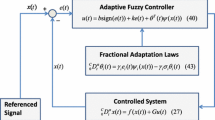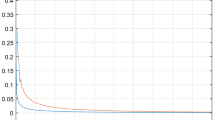Abstract
This paper presents a novel approach for stabilizing fractional-order (FO) nonlinear systems with distributed time-varying delays and input constraints. It utilizes an interval type-2 fuzzy systems (IT2FS) to effectively manage uncertainties and complexities in the system. By combining various theories, a new methodology is proposed for designing a stabilization controller. Sufficient conditions guarantee the stability of the closed-loop system, addressing challenges of varying delays and controller saturation. The results are expressed as linear matrix inequalities (LMIs), facilitating implementation with the Matlab LMIs toolbox. This study contributes to advancing control theory by developing stabilization techniques for fractional nonlinear systems.




Similar content being viewed by others
Data Availability
No data was used for the research described in the article.
References
Abualigah L, Yousri D, Elaziz MA (2021) Aquila optimizer: a novel meta-heuristic optimization algorithm. Comput Ind Eng 157:107250. https://doi.org/10.1016/j.cie.2021.107250
Abualigah L, Elaziz MA, Sumari P (2022) Reptile search algorithm (RSA): a nature-inspired meta-heuristic optimizer. Expert Syst Appl 191:116158. https://doi.org/10.1016/j.eswa.2021.116158
Abualigaha L, Diabatb A, Mirjalili S et al (2021) The arithmetic optimization algorithm. Comput Methods Appl Mech Eng 376:113609. https://doi.org/10.1016/j.cma.2020.113609
Agushakaa JO, Ezugwua AE, Abualigah L (2022) Dwarf mongoose optimization algorithm. Comput Methods Appl Engrg 391:114570. https://doi.org/10.1016/j.cma.2022.114570
Alijani Z, Kangro U (2021) On the smoothness of the solution of fuzzy volterra integral equations of the second kind with weakly singular kernels. Numer Funct Anal Optim 42(7):819–833. https://doi.org/10.1080/01630563.2021.1931312
Alijani Z, Kangro U (2021) Numerical solution of a linear fuzzy Volterra integral equation of the second kind with weakly singular kernels. Soft Comput 26:12009–12022. https://doi.org/10.1007/s00500-022-07477-y
Alijani Z, Shiri B, Perfilieva I et al (2023) Numerical solution of a new mathematical model for intravenous drug administration. Evol Intell. https://doi.org/10.1007/s12065-023-00840-4
An J, Wen G, Li R (2011) New results on a delay-derivative-dependent fuzzy \(H_{\infty }\) filter design for TCS fuzzy systems. IEEE Trans Fuzzy Syst 19(4):770–779
Butzer P, Westphal U (2000) An introduction to fractional calculus. World Scientific, Singapore
Chaibi R, Tissir E, Hmamed A et al (2019) Static output feedback controller for continuous-time fuzzy systems. Int J Innov Comput Inf Control 15(4):1469–484
Chang XH, Zhang L, Park JH (2015) Robust static output feedback \(H_{\infty }\) control for uncertain fuzzy systems. Fuzzy Sets Syst 273:87–104
Chang XH, Zhang L, Park JH (2015) Robust static output feedback \(H_{\infty }\) control for uncertain fuzzy systems. Fuzzy Sets Syst 273:87–104
Chen B, Chen J (2015) Razumikhin-type stability theorems for functional fractional-order differential systems and applications. Appl Math Comput 254:63–69
Cheng YL, Hu TT, Li YH et al (2021) Consensus of fractional-order multi-agent systems with uncertain topological structure: A Takagi-Sugeno fuzzy event-triggered control strategy. Fuzzy Sets Syst 416:64–85
Divya H, Sakthivel R, Liu Y et al (2021) Delay-dependent synchronization of T-S fuzzy Markovian jump complex dynamical networks. Fuzzy Sets Syst 416:108–124
Duan RR, Li JM, Chen JX (2019) Mode-dependent non-fragile observer-based controller design for fractional-order T-S fuzzy systems with Markovian jump via non-PDC scheme. Nonlinear Anal Hybrid Syst 34:74–91
Ezugwu AE, Agushaka JO, Abualigah L (2022) Prairie dog optimization algorithm. Neural Comput Appl 34(22):20017–20065. https://doi.org/10.1007/s00521-022-07530-9
Fan XF, Wang ZS, Shi Z (2021) Event-triggered integral sliding mode control for uncertain fuzzy systems. Fuzzy Sets Syst 416:47–63
Guo YC (2020) Fractional-order T-S fuzzy predictive control based free-form Surface reconstruction. Multim Tools Appl 9(23–24):16955–16966
Hao Y, Zhang X (2021) T-S fuzzy control of uncertain fractional-order systems with time delay. J Math. https://doi.org/10.1155/2021/6636882
Huong DC, Thuan MV (2020) Mixed \(H_{\infty }\) and passive control for fractional-order nonlinear systems via LMI approach. Acta Appl Math 170:37–52
Jafari P, Teshnehlab M, Tavakoli KM (2018) Adaptive type-2 fuzzy system for synchronisation and stabilisation of chaotic non-linear fractional order systems. IET Control Theory Appl 12(2):183–193
Ji HH, Cui BT (2022) Event-generator-based \(H_\infty \) control of fuzzy distributed parameter systems. Fuzzy Sets Syst 432:28–49. https://doi.org/10.1016/j.fss.2021.03.012
Kilbas A, Srivastava H, Trujillo J (2006) Theory and application of fractional differential equations. Elsevier, New York
Lee SM (2019) Novel stabilization criteria for T-S fuzzy systems with affine matched membership functions. IEEE Trans Fuzzy Syst 27(3):540–548
Li CG, Chen GR (2004) Chaos and hyperchaos in the fractional-order Rossler equations. Physica A 34(1):55–61
Li C, Deng W (2007) Remarks on fractional derivatives. Appl Math Comput 187(2):777–784
Li YT, Li JM (2016) Decentralized stabilization of fractional order T-S fuzzy interconnected systems with multiple time delays. J Intell Fuzzy Syst 30(1):319–331
Li YM, Yu KT (2022) Adaptive fuzzy decentralized sampled—data control for large-scale nonlinear systems. IEEE Trans Fuzzy Syst 30(6):1809–1822. https://doi.org/10.1109/TFUZZ.2021.3069321
Li Y, Liu L, Feng G (2020) Finite-time \(H_{\infty }\) controller synthesis of T-S fuzzy systems. IEEE Trans Syst Man Cybern Syst 50(5):1956–1963
Liang S, Wu R, Chen L (2016) Adaptive pinning synchronization in fractional-order uncertain complex dynamical networks with delay. Physica A 444:49–62
Liang BY, Zheng SQ, Ck Ahn et al (2022) Adaptive fuzzy control for fractional-order interconnected systems with unknown control directions. IEEE Trans Fuzzy Syst 30(1):75–87. https://doi.org/10.1109/TFUZZ.2020.3031694
Mo H, Wang FY, Zhou M et al (2014) Footprint of uncertainty for type-2 fuzzy sets. Inf Sci 272:96–100
Mirzajani S, Aghababa M, Heydari A (2019) Adaptive control of nonlinear fractional-order systems using T-S fuzzy method. Int J Mach Learn Cybern 10(3):527–540
Mirzajani S, Aghababa M, Heydari A (2019) Adaptive T-S fuzzy control design for fractional-order systems with parametric uncertainty and input constraint. Fuzzy Sets Syst 365:22–39
Mu Y, Zhang H, Ren H et al (2021) Fuzzy adaptive observer-based fault and disturbance reconstructions for T-S fuzzy systems. IEEE Trans Circuits Syst II Express Briefs 68(7):2453–2457
Oyelade ON, Ezugwua AE, Mohamed TIA et al (2022) Ebola optimization search algorithm: a new nature-inspired metaheuristic algorithm with application in medical image classification problem. IEEE Access 10:16150–16177. https://doi.org/10.1109/ACCESS.2022.3147821
Padmaja N, Balasubramaniam P (2022) Mixed \(H_{\infty } /\)passivity based stability analysis of fractional-order gene regulatory networks with variable delays. Math Comput Simul 192:167–181
Peng X, Wu H (2020) Non-fragile robust finite-time stabilization and \(H_{\infty }\) performance analysis for fractional-order delayed neural networks with discontinuous activations under the asynchronous switching. Neural Comput Appl 32:4045–4071
Shiri B (2022) A unified generalization for Hukuhara types differences and derivatives: Solid analysis and comparisons. Mathematics. https://doi.org/10.3934/math.2023112
Shiri B, Perfilieva I, Alijani Z (2021) Classical approximation for fuzzy Fredholm integral equation. Fuzzy Sets Syst 404:159–177. https://doi.org/10.1016/j.fss.2020.03.023
Shiri B, Alijani Z, Karaca Y (2023) A power series method for the fuzzy fractional logistic differential equation. Fractals. https://doi.org/10.1142/S0218348X23400868
Song S, Song X, Balsera I (2017) Adaptive projective synchronization for fractional-order T-S fuzzy neural networks with time-delay and uncertain parameters. Optik 129:140–152
Song S, Song X, Tejado I (2019) Projective synchronization for two nonidentical time-delayed fractional-order T-S fuzzy neural networks based on mixed \(H_{\infty }\) passive adaptive sliding mode control. Int J Mach Learn Cybern 10(5):799–812
Takagi T, Sugeno M (1985) Fuzzy identification of systems and its applications to modeling and control. IEEE Trans Syst Man Cybern Syst 15(1):116–1332
Wang LX (2020) Fast training algorithms for deep convolutional fuzzy systems with application to stock index prediction. IEEE Trans Fuzzy Syst 28(7):1301–1314
Wang LX, Mendel JM (2016) Fuzzy opinion networks: a mathematical framework for the evolution of opinions and their uncertainties across social networks. IEEE Trans Fuzzy Syst 24(4):880–905
Wang CJ, Zhou SS, Kong YY (2016) State feedback control of interval type-2 T-S model based uncertain stochastic systems with unmatched premises. Neurocomputing 173(3):1082–1095
Wu XR, AI QM, Wang YN, (2021) Adaptive and exponential synchronization of uncertain fractional-order T-S fuzzy complex networks with coupling time-varying delays via pinning control strategy. IEEE Access 9:2007–2017
Zhang XF, Huang WK (2021) Robust \(H_{\infty }\) adaptive output feedback sliding mode control for interval type-2 fuzzy fractional-order systems with actuator faults. Nonlinear Dyn 104(1):537–550
Zhang X, Jin K (2020) Design of non-fragile controller for singular fractional order Takag-Sugeno fuzzy systems. Int J Fuzzy Syst 22(4):1289–1298
Zhang XF, Jin KJ (2020) Dynamic output feedback controller design for interval type-2 T-S fuzzy fractional order systems. IET Control Theory Appl 14(18):2857–2867
Zhang X, Zao Z (2020) Normalization and stabilization for rectangular singular fractional order T-S fuzzy systems. Fuzzy Sets Syst 381:140–153
Zhao N, Shi P, Xing W et al (2021) Resilient adaptive event-triggered fuzzy tracking control and filtering for nonlinear networked systems under denial of service attacks. IEEE Trans Fuzzy Syst. https://doi.org/10.1109/TFUZZ.2021.3106674
Author information
Authors and Affiliations
Corresponding author
Ethics declarations
Funding
This paper does not have funding support.
Conflict of interest
Zhile Xia declares that he has no conflict of interest.
Human participants
This article does not contain any studies with human participants or animals performed by any of the authors.
Additional information
Publisher's Note
Springer Nature remains neutral with regard to jurisdictional claims in published maps and institutional affiliations.
Appendix A
Appendix A
Proof of Lemma 5
Assume that the element at position (i, j) of matrix P is \(p_{ij}(i,j=1,2,\ldots ,n)\), the ith component of the function \(x(\theta )\) is \(x_{i}(\theta )(i=1,2,\ldots ,n)\), then there
Just prove that at any moment, when \(\theta _1=\theta _2=\theta \), \(x^T(\theta _1)Px(\theta _2)\) and \(x^T(\theta )Px(\theta )\) must have the same supremum.
In fact, since P is a positive definite matrix, we can get
i.e.,
The matrix P is positive definite symmetric, so
therefore
So when \(\theta _1=\theta _2=\theta \), The equal sign of the above equation is established. So the supremum of function \(x^T(\theta _1)Px(\theta _2)\) must be obtained at \(\theta _1=\theta _2\), so
The proof is complete. \(\square \)
Rights and permissions
Springer Nature or its licensor (e.g. a society or other partner) holds exclusive rights to this article under a publishing agreement with the author(s) or other rightsholder(s); author self-archiving of the accepted manuscript version of this article is solely governed by the terms of such publishing agreement and applicable law.
About this article
Cite this article
Xia, Z. Saturation controller design for fractional-order interval type-2 fuzzy system with distributed time-varying delays. Soft Comput 28, 153–161 (2024). https://doi.org/10.1007/s00500-023-09297-0
Accepted:
Published:
Issue Date:
DOI: https://doi.org/10.1007/s00500-023-09297-0




